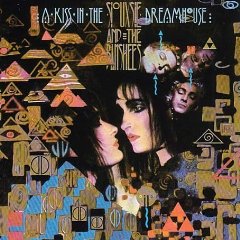A Kiss In The Dreamhouse
Nocturne
Hyaena
Tinderbox
They may have owed little to the punk scene that spawned them but they were indebted even less to the imitators that followed in their footsteps. With many of their 100 Club peers long gone or slowly falling apart, Siouxsie & The Banshees entered the 1980s in a state of rude health that was to produce some of their best work.
Having broken free from the shackles of punk, these four re-mastered albums – the next in series of The Banshees’ back catalogue to receive the aural VIP treatment – prove conclusively that Siouxsie & The Banshees were one of the great British psychedelic bands. Indeed, speaking recently with this writer, bassist Steven Severin admitted that the band’s influences hailed from areas not normally associated with the Class of ’76.
"We did actually spend a long time listening to the White Album and things like that and, of course, Relics by Pink Floyd," he said. "[Guitarist John] McGeoch and I spoke a lot about the period before the Rolling Stones went totally psychedelic like ‘Aftermath’ or The Beatles’ ‘Revolver’; not quite the mushroom world but on its way."
Listening back to 1982’s A Kiss In The Dreamhouse is to re-discover music that was fundamentally pop yet unafraid to revel in a quirkiness born of altered states. A deliberate shift from the overt darkness of its predecessor, Juju, . . . Dreamhouse was the first Banshees album that the principle players – singer Siouxsie Sioux, Severin, McGeoch and percussion genius Budgie – fashioned from scratch. Having gelled during of a nine-month tour, The Banshees had arrived at an almost telepathic understanding of each and the result was their most colourful and – ahem – kaleidoscopic collection yet.
The layers of twelve-string guitar and flanged effects from McGeoch’s fingers on opener ‘Cascade’ flow with a seamless beauty as elsewhere and throughout, Siouxsie’s voice achieves a sense of strength and maturity that she’s been building up to over the previous albums. As the ears are re-acquainted with the menacingly whimsical ‘Green Fingers’, it becomes apparent that Steven Severin was a bassist every bit as idiosyncratic and inventive as bass pirate Peter Hook.
A Kiss In The Dreamhouse benefits from a wide range of musical styles and lyrical subject matter. ‘Obsession’ is a forerunner of Nick Cave’s ‘From Her To Eternity’ while ‘She’s A Carnival’, complete with a sinister fairground organ coda, is simply dazzling and, as displayed by the motorik drive of ‘Slowdive’, Siouxsie & The Banshees weren’t afraid to stretch themselves. Here was a band that dared to challenge itself as much as their listeners.
And yet, at the moment they moment they should have been punching the air in triumph, the wheels came off Siouxsie & The Banshees’ wagon thanks to the sudden and unscheduled departure of John McGeoch. A breakdown in Spain hospitalised the exhausted guitarist and he was replaced in short order by The Cure’s Robert Smith. Coasting on the back of the Top three hit, ‘Dear Prudence’, Siouxsie & The Banshees made a two-night stand at the prestigious Royal Albert Hall and the result was Nocturne. An anomaly among live albums, Nocturne bears repeated listens and despite reportedly awful onstage sound, the band are taut and urgent with Siouxsie in her finest ice-maiden guise as she heaps withering contempt on those audience members shouting out for ‘Love In A Void’ ("What time tunnel did you come through?") as much as she does on her band ("Can’t you get out of tune any faster?").
With The Cure on hold and Smith still reeling from the emotional lyrical intensity of Pornography, Siouxsie and The Banshees repaired back to the studio to make Hyaena. Their most experimental work, Smith’s presence in keenly felt on the disciplined execution of the grandiose ‘Dazzle’ or the starkly seductive ‘Swimming Horses’. But the real treasures were buried deep within the album. The lysergic Spaghetti Western twang of ‘Bring Me The Head Of The Preacher Man’ is evocative in its execution while the densely epic ‘Blow The House Down’ finds Smith indelibly stamping his mark on the track courtesy of some his finest guitar work.
Yet no sooner had the album been completed and Siouxsie & The Banshees found themselves in a predicament they could set their watches by: the departure of yet another guitarist. The success of ‘The Walk’ promoted Smith the re-assemble a new incarnation of The Cure while The Banshees satisfied themselves with the rapid recruitment of former Clock DVA guitarist John Curruthers.
It was a situation that proved to be anything but a handicap. By removing the focus from the guitar, Siouxsie & The Banshees forged a sound that was totally their own. Rhythmic and percussive, the rock idiom of old was eschewed in favour of a sound that was wholly their own. ‘Cities In Dust’, the first taster from Tinderbox, found the band moving into more electronic climes as Severin’s recently purchased DX-7 synth discovered new territories to explore. Siouxsie, meanwhile, was moved to condemn the then-spiralling use of heroin on the commentary of ‘Candyman’.
What these re-issues serve to highlight more than anything else is one of the last periods of genuinely creative and forward-thinking episodes in British rock. Having seized upon punk’s go-for-it ethos, Siouxsie & The Banshees carved out an identity that was entirely of their own making.
In Siouxsie Sioux, the band possessed one the greatest frontwomen to have ever taken a stage; a strong, determined and, above all, inspirational figure, her bullshit-free demeanour was the perfect riposte to the boys club that was and remains the music industry while the rest of the band, in all their various guises with Budgie and Severin at the helm, provided a sublimely inventive powerhouse that frequently stormed the pop charts with all the surprise and vigour of a Viking raiding party. Those may have been different times but this was a different band. Remember them this way.


